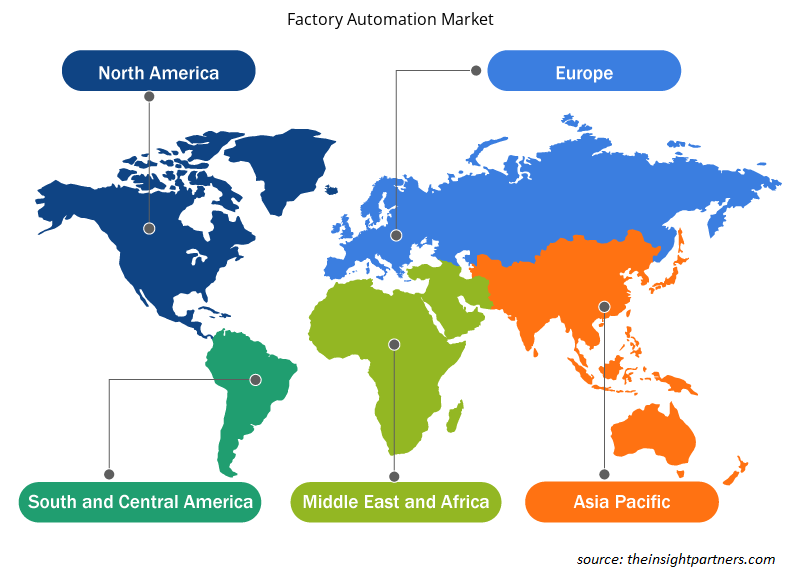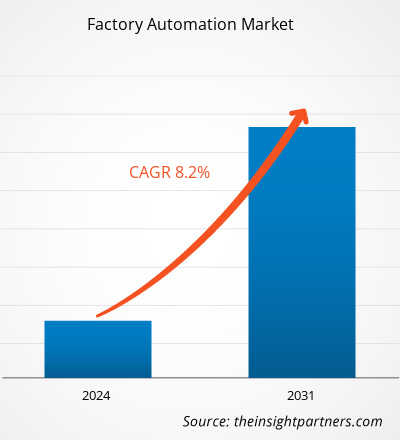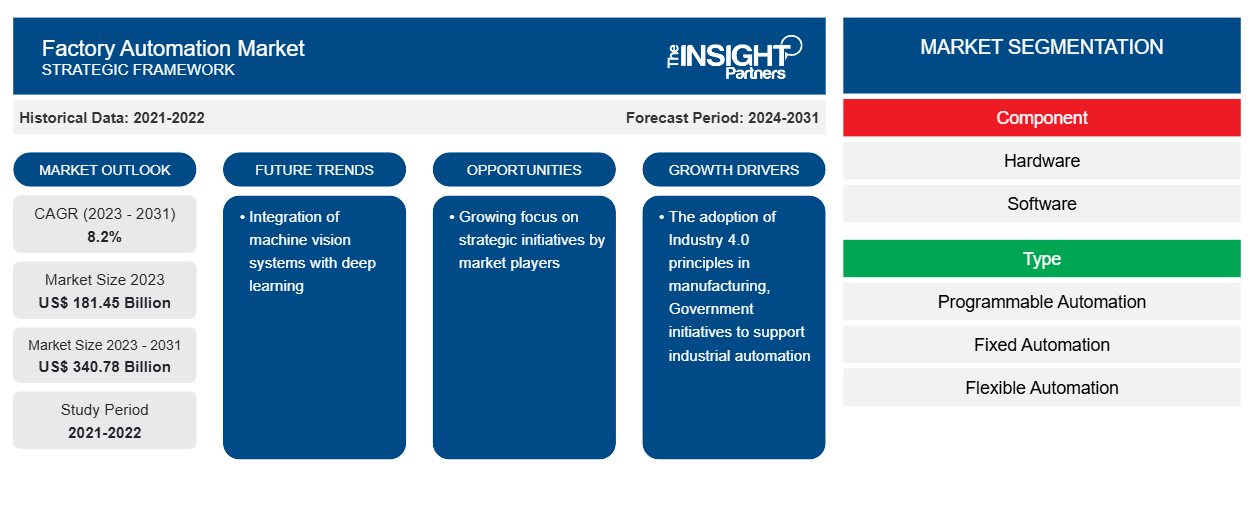Se proyecta que el mercado de automatización de fábricas crecerá de US$ 181,45 mil millones en 2023 a US$ 340,78 mil millones en 2031; se espera que se expanda a una CAGR del 8,2% entre 2023 y 2031. Se anticipa que la integración de sistemas de visión artificial con aprendizaje profundo será una tendencia clave en el mercado.
Análisis del mercado de automatización de fábricas
El negocio de la fabricación se ha expandido rápidamente durante la última década. La globalización está expandiendo el mercado, atrayendo a una gran cantidad de nuevos actores. La ventaja competitiva en el mercado de la automatización de fábricas para las empresas clave se puede construir a través de la diferenciación de productos, el liderazgo en costos, el marketing dirigido y un excelente servicio posventa. La automatización es un factor crítico para los procesos de producción. Además, las soluciones de automatización avanzadas permiten lograr una alta calidad constante, un alto rendimiento y bajos costos de producción. Por lo tanto, se espera que el mercado de la automatización de fábricas crezca durante el período de pronóstico.
Descripción general del mercado de automatización de fábricas
La automatización de fábricas es la integración de la automatización en todas las etapas del proceso de fabricación. La automatización en la fabricación combina con frecuencia tecnologías como sistemas neumáticos , sistemas hidráulicos y brazos robóticos para producir un sistema más complejo. En un entorno competitivo, la automatización de fábricas puede ayudar a aumentar la producción y la eficiencia, al tiempo que reduce los costos. La automatización de fábricas ofrece un método convincente para aumentar la eficiencia, la calidad, la sostenibilidad, la seguridad y la protección en un entorno de fábrica moderno que cambia rápidamente.
Personalice este informe según sus necesidades
Obtendrá personalización en cualquier informe, sin cargo, incluidas partes de este informe o análisis a nivel de país, paquete de datos de Excel, así como también grandes ofertas y descuentos para empresas emergentes y universidades.
-
Obtenga las principales tendencias clave del mercado de este informe.Esta muestra GRATUITA incluirá análisis de datos, desde tendencias del mercado hasta estimaciones y pronósticos.
Impulsores del mercado y oportunidades de la automatización de fábricas
Adopción del principio de Industria 4.0 en la manufactura para favorecer el crecimiento del mercado.
El poder revolucionario de la Cuarta Revolución Industrial (Industria 4.0) está alterando la producción global. La Industria 4.0, que se define (en parte) por sistemas inteligentes, inteligencia artificial (IA), big data y arquitectura de TI avanzada, representa el siguiente paso en la evolución de la fabricación en su conjunto y muchas empresas están adoptando estas tecnologías. Los beneficios de los procesos, tecnologías y sistemas de la Industria 4.0 incluyen una mayor productividad y eficiencia, mayor agilidad y flexibilidad y mayor rentabilidad. Por lo tanto, se prevé que la adopción de la Industria 4.0 para la automatización en numerosas industrias impulse el crecimiento del mercado de automatización de fábricas durante el período de pronóstico.
Creciente atención a las iniciativas estratégicas por parte de los actores del mercado
Se espera que el creciente enfoque de los principales participantes del mercado en actividades estratégicas como fusiones, adquisiciones y colaboraciones, entre otras, impulse el crecimiento del mercado de la automatización de fábricas. Por ejemplo, en julio de 2021, Rockwell Automation, Inc., dedicada a la automatización industrial y la transformación digital, anunció la adquisición de Plex Systems, la plataforma líder de fabricación inteligente nativa de la nube. Además, en septiembre de 2021, Rockwell Automation, Inc. anunció una asociación con Kezzler, una plataforma de digitalización y trazabilidad de productos basada en la nube, para ayudar a los fabricantes a capturar el recorrido de sus productos desde las fuentes de materia prima hasta el punto de venta o más allá utilizando soluciones de cadena de suministro basadas en la nube que se centran en la trazabilidad del producto.Plex Systems, the leading cloud-native smart manufacturing platform. Further, in September 2021, Rockwell Automation, Inc. announced a partnership with Kezzler, a cloud-based product digitization and traceability platform, to help manufacturers capture the journey of their products from raw material sources to point-of-sale or beyond using cloud-based supply chain solutions that focus on product traceability.
Análisis de segmentación del informe de mercado de automatización de fábrica
Los segmentos clave que contribuyeron a la derivación del análisis del mercado de automatización de fábrica son el componente, el tipo, la tecnología y la vertical de la industria.
- Según los componentes, el mercado se divide en hardware y software.
- Según el tipo, el mercado se divide en automatización programable, automatización fija y automatización flexible.
- Según la tecnología, el mercado se divide en controlador lógico programable (PLC), sistemas de control distribuido (DCS), sistemas de control de supervisión y adquisición de datos (SCADA), interfaz hombre-máquina (HMI) y otros.
- Sobre la base de la industria vertical, el mercado se divide en automotriz, alimentos y bebidas, petróleo y gas, manufactura, minería y otros.
Análisis de la cuota de mercado de la automatización de fábricas por geografía
Según la región, el mercado está segmentado en América del Norte, Europa, Asia Pacífico, Medio Oriente y África, y América del Sur y Central.
Se espera que América del Norte ocupe una parte importante del mercado de automatización de fábricas durante el período de pronóstico. Este crecimiento puede atribuirse a la adopción temprana de tecnología y a un fuerte énfasis en las actividades de investigación y desarrollo. Además, se prevé que la creciente popularidad de los robots colaborativos y las iniciativas gubernamentales para la transformación digital en todas las industrias impulsen el mercado de automatización de fábricas durante el período de pronóstico.
Perspectivas regionales del mercado de automatización de fábricas
Los analistas de Insight Partners explicaron en detalle las tendencias y los factores regionales que influyen en el mercado de automatización de fábricas durante el período de pronóstico. Esta sección también analiza los segmentos y la geografía del mercado de automatización de fábricas en América del Norte, Europa, Asia Pacífico, Oriente Medio y África, y América del Sur y Central.

- Obtenga datos regionales específicos para el mercado de automatización de fábricas
Alcance del informe de mercado de automatización de fábricas
| Atributo del informe | Detalles |
|---|---|
| Tamaño del mercado en 2023 | US$ 181,45 mil millones |
| Tamaño del mercado en 2031 | US$ 340,78 mil millones |
| CAGR global (2023 - 2031) | 8,2% |
| Datos históricos | 2021-2022 |
| Período de pronóstico | 2024-2031 |
| Segmentos cubiertos |
Por componente
|
| Regiones y países cubiertos |
América del norte
|
| Líderes del mercado y perfiles de empresas clave |
|
Densidad de actores del mercado de automatización de fábricas: comprensión de su impacto en la dinámica empresarial
El mercado de automatización de fábricas está creciendo rápidamente, impulsado por la creciente demanda de los usuarios finales debido a factores como la evolución de las preferencias de los consumidores, los avances tecnológicos y una mayor conciencia de los beneficios del producto. A medida que aumenta la demanda, las empresas amplían sus ofertas, innovan para satisfacer las necesidades de los consumidores y aprovechan las tendencias emergentes, lo que impulsa aún más el crecimiento del mercado.
La densidad de actores del mercado se refiere a la distribución de las empresas o firmas que operan dentro de un mercado o industria en particular. Indica cuántos competidores (actores del mercado) están presentes en un espacio de mercado determinado en relación con su tamaño o valor total de mercado.
Las principales empresas que operan en el mercado de automatización de fábricas son:
- Compañía: ABB Ltd.
- Compañía Eléctrica Emerson
- Corporación Fanuc
- Compañía General Electric
- Corporación Mitsubishi Electric
- Compañía: Honeywell International Inc.
Descargo de responsabilidad : Las empresas enumeradas anteriormente no están clasificadas en ningún orden particular.

- Obtenga una descripción general de los principales actores clave del mercado de automatización de fábricas
Noticias y desarrollos recientes del mercado de automatización de fábricas
El mercado de la automatización de fábricas se evalúa mediante la recopilación de datos cualitativos y cuantitativos a partir de una investigación primaria y secundaria, que incluye publicaciones corporativas importantes, datos de asociaciones y bases de datos. A continuación se enumeran algunos de los avances en la automatización de fábricas:
- Mitsubishi Electric Corporation anunció que invertirá aproximadamente 2.200 millones de rupias indias, o 3.100 millones de yenes, en su filial Mitsubishi Electric India Pvt. Ltd. para establecer una nueva fábrica en la India. Se espera que la nueva fábrica comience a operar en diciembre de 2023 y fabricará inversores y otros productos de sistemas de control de automatización de fábrica (FA), ampliando las capacidades de la empresa para satisfacer la creciente demanda en la India. (Fuente: Mitsubishi Electric Corporation, comunicado de prensa, junio de 2022)
Informe sobre el mercado de automatización de fábricas: cobertura y resultados
El pronóstico del mercado de automatización de fábricas se estima en función de varios hallazgos de investigación primaria y secundaria, como publicaciones de empresas clave, datos de asociaciones y bases de datos. El informe de mercado "Tamaño y pronóstico del mercado de automatización de fábricas (2021-2031)" proporciona un análisis detallado del mercado que cubre las siguientes áreas:
- Tamaño del mercado de automatización de fábricas y pronóstico a nivel global, regional y nacional para todos los segmentos clave del mercado cubiertos bajo el alcance
- Tendencias del mercado de automatización de fábricas, así como dinámicas del mercado, como impulsores, restricciones y oportunidades clave
- Análisis detallado de las cinco fuerzas de Porter y PEST y FODA
- Análisis del mercado de automatización de fábricas que cubre las tendencias clave del mercado, el marco global y regional, los principales actores, las regulaciones y los desarrollos recientes del mercado.
- Panorama de la industria y análisis de la competencia que abarca la concentración del mercado, análisis de mapas de calor, actores destacados y desarrollos recientes en el mercado de automatización de fábricas.
- Perfiles detallados de empresas.
- Análisis histórico (2 años), año base, pronóstico (7 años) con CAGR
- Análisis PEST y FODA
- Tamaño del mercado, valor/volumen: global, regional y nacional
- Industria y panorama competitivo
- Conjunto de datos de Excel
Informes recientes
Testimonios
Razón para comprar
- Toma de decisiones informada
- Comprensión de la dinámica del mercado
- Análisis competitivo
- Información sobre clientes
- Pronósticos del mercado
- Mitigación de riesgos
- Planificación estratégica
- Justificación de la inversión
- Identificación de mercados emergentes
- Mejora de las estrategias de marketing
- Impulso de la eficiencia operativa
- Alineación con las tendencias regulatorias























 Obtenga una muestra gratuita para - Mercado de automatización de fábricas
Obtenga una muestra gratuita para - Mercado de automatización de fábricas